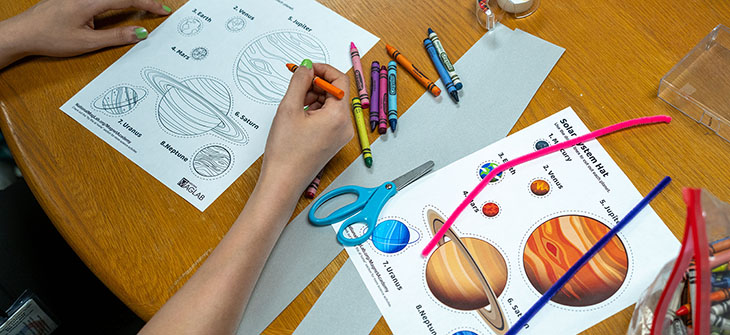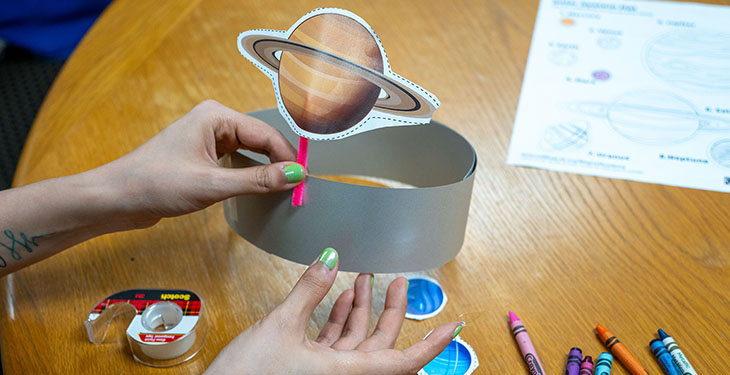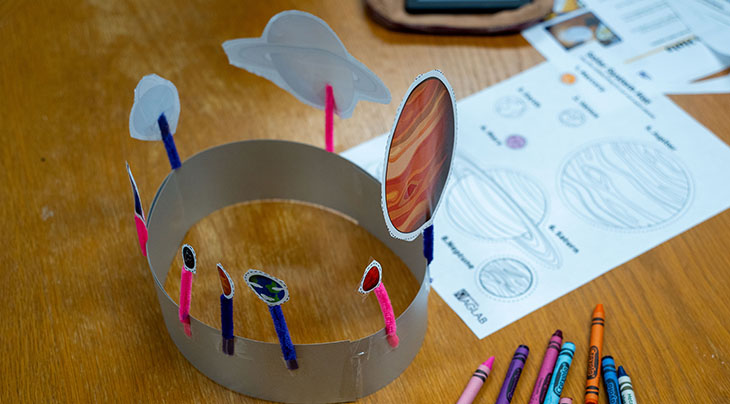Look up at the night sky, and you’re not just seeing stars. Some of those glimmering points of light are our neighbors in the solar system.
Earth is one of 8 planets orbiting the sun, along with Pluto, once known as the ninth planet but now reclassified as a dwarf planet.
The planets come in a variety of sizes, spins, orbits and atmospheres.
Mercury, the smallest and closest to the sun, orbits every 88 Earth Days. Because it’s so close to the sun, daytime temperatures can reach 800° Fahrenheit. Then, because it has no atmosphere, at night temps can drop to a frigid -290°.
Venus is second from the sun and even hotter than Mercury because of its heat-trapping atmosphere. Temperatures hit about 900° F, hot enough to melt lead. Venus rotates the opposite direction of most planets, and it rotates so slowly, one day lasts the equivalent of half a year on earth. Mercury and Venus are the only planets in the solar system with no rings and no moons.
Earth is the third planet from the sun, the only one in the solar system where conditions are just right for life. As you know, Earth is home to lots of people, 8.1 billion or so, along with an abundance of animals and plants. You don’t feel it, but we’re all on the move, all the time. Our planet spins on its axis at 1,000 miles per hour and orbits the Sun at 67,000 mph.
Mars, our next-door neighbor and the fourth planet from the sun, is about half the size of Earth. It’s known as the red planet because of rusting of iron on its dry, rocky, dusty surface. Two rovers have landed on and explored Mars, and eight spacecraft orbit the red planet.
Jupiter is the fifth and largest planet in the solar system, a thousand times bigger than Earth. This giant of swirling gas and liquids has no real surface, and its extreme pressures would crush a spacecraft.
Saturn, another gas giant with no real surface, is made of hydrogen and helium. The sixth planet from the sun is known for its spectacular, complex rings, made of chunks of ice and rock. Saturn also has more moons than any other planet, at 146.
Uranus, seventh from the sun, is known as an ice giant, a planet of swirling fluids with a low temperature of about -380° and winds of up to 560 miles per hour. Uranus rotates at a nearly 90° angle compared to its orbit, making it appear to spin on its side.
Neptune is another ice giant and the eighth and most distant planet from the sun. So far away, it is the only planet in our solar system you can’t see with the naked eye. It takes 165 Earth years for Neptune to orbit the sun, and each season lasts about 40 years!
Source: NASA
Researchers at the MagLab are investigating how our solar system formed billions of years ago by probing an ancient meteorite with high magnetic fields.
What you’ll need:
- A sheet of the 8 planets of our solar system
- Cardboard or construction paper
- Printer & printer paper
- Pipe cleaners
- Scissors
- Tape
- Crayons or colored markers
What you'll do:
1. Print out on white paper our sheets showing the 8 planets of our solar system
2. You can print the colored or the black and white version
3. For black and white, color each planet using crayons or markers. Use colors that match the descriptions or get creative.

4. Cut the cardboard or construction paper into two thin strips, about two or three inches wide.
5. Connect the thin strips end to end to form a longer strip. Place the strip around your head, then using tape or staples connect the strip into a loop to make a head band.

6. Cut the pipe cleaners in half or in thirds until you have eight.

7. Tape your planets to each of the pipe cleaners.
8. Tape the pipe cleaners on the cardboard or construction paper, perpendicular to the strip, and in the order of the planets relative to the sun.

9. Place the band back on your head and show off your new solar system hat!

Did you know?
- Scientists have analyzed lunar soil from the NASA Apollo missions, meteors that crashed to Earth, and dust from Saturn’s largest moon, seeking clues about the mysteries of the universe.